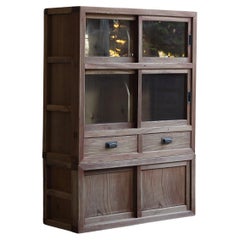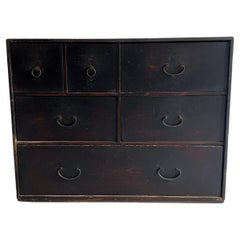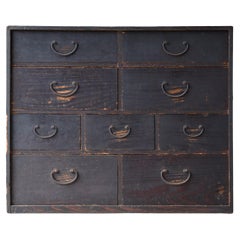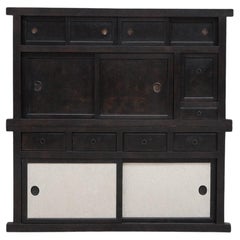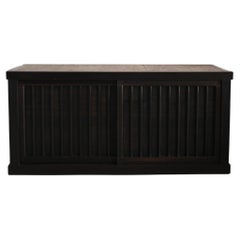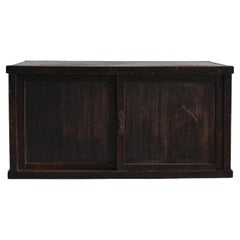Tansu Wabi Sabi
Early 20th Century Japanese Taisho Antiquities
Wood
Antique 19th Century Japanese Meiji Cabinets
Cedar, Pine, Paper
Early 20th Century Japanese Edo Commodes and Chests of Drawers
Cedar
Early 20th Century Japanese Meiji Commodes and Chests of Drawers
Cedar
Early 20th Century Japanese Taisho Furniture
Elm, Cedar, Paper
Antique Late 19th Century Japanese Sideboards
Cedar
Antique 19th Century Japanese Meiji Credenzas
Iron
Antique 19th Century Japanese Sideboards
Brass, Iron
Antique 19th Century Japanese Meiji Commodes and Chests of Drawers
Iron
Early 20th Century Japanese Taisho Cabinets
Wood
Antique Mid-19th Century Japanese Ladders
Cedar
Antique 19th Century Japanese Edo Furniture
Wood
Antique Early 19th Century Japanese Edo Commodes and Chests of Drawers
Iron
Antique 19th Century Japanese Meiji Sideboards
Cedar
Antique Late 19th Century Japanese Meiji Cabinets
Cedar
Early 20th Century Japanese Meiji Commodes and Chests of Drawers
Cedar
Antique Late 19th Century Japanese Edo Commodes and Chests of Drawers
Wood, Cedar
Early 20th Century Japanese Meiji Sideboards
Wood
Early 20th Century Japanese Meiji Commodes and Chests of Drawers
Cedar
Antique Mid-19th Century Japanese Cabinets
Iron
Antique Late 19th Century Japanese Meiji Cabinets
Cedar
Early 20th Century Japanese Meiji Commodes and Chests of Drawers
Cedar
Early 20th Century Japanese Meiji Sofa Tables
Cedar
Antique Late 19th Century Japanese Edo Sofa Tables
Cedar
Antique Mid-19th Century Japanese Edo Commodes and Chests of Drawers
Wood, Cedar
Early 20th Century Japanese Organic Modern Cabinets
Iron
Antique 19th Century Coffee and Cocktail Tables
Cedar
Early 20th Century Japanese Bohemian Cabinets
Fruitwood
Early 20th Century Japanese Taisho Cabinets
Iron
Early 20th Century Japanese Meiji Commodes and Chests of Drawers
Cedar
Antique Late 19th Century Japanese Edo Commodes and Chests of Drawers
Wood
Early 20th Century Japanese Meiji Commodes and Chests of Drawers
Cedar
Early 20th Century Japanese Meiji Side Tables
Cedar
Early 20th Century Japanese Taisho Cabinets
Wood, Cedar, Pine
Early 20th Century Japanese Meiji Commodes and Chests of Drawers
Wood
Early 20th Century Japanese Taisho Furniture
Wood
Antique 19th Century Japanese Meiji Commodes and Chests of Drawers
Bronze, Iron
Early 20th Century Japanese Meiji Commodes and Chests of Drawers
Wood
Antique Early 19th Century Japanese Edo Cupboards
Cedar, Pine
Antique 19th Century Japanese Meiji Cabinets
Iron
Vintage 1920s Asian Taisho Cabinets
Cedar
Antique Mid-19th Century Japanese Edo Cabinets
Iron
Antique Early 1900s Japanese Meiji Cabinets
Cedar, Pine
Early 20th Century Japanese Taisho Antiquities
Wood
Early 20th Century Japanese Meiji Commodes and Chests of Drawers
Wood, Reclaimed Wood
Antique 19th Century Japanese Edo Commodes and Chests of Drawers
Elm, Cedar
Early 20th Century Japanese Taisho Cabinets
Wood
Early 20th Century Japanese Taisho Cabinets
Wood
Early 20th Century Japanese Meiji Commodes and Chests of Drawers
Cedar
Vintage 1910s Japanese Sideboards
Glass, Cedar
Vintage 1920s Japanese Taisho Cabinets
Cedar, Paper
Antique 19th Century Edo Commodes and Chests of Drawers
Cedar
Early 20th Century Japanese Meiji Cabinets
Cedar
Early 20th Century Japanese Meiji Cabinets
Cedar
Early 20th Century Japanese Meiji Cabinets
Cedar
Antique 19th Century Japanese Meiji Sideboards
Cedar
Early 20th Century Japanese Meiji Commodes and Chests of Drawers
Cedar
Antique 19th Century Japanese Meiji Commodes and Chests of Drawers
Iron
Early 20th Century Japanese Meiji Cabinets
Cedar
Early 20th Century Japanese Meiji Cabinets
Cedar
- 1
Tansu Wabi Sabi For Sale on 1stDibs
How Much is a Tansu Wabi Sabi?
Finding the Right storage-case-pieces for You
Of all the antique and vintage case pieces and storage cabinets that have become popular in modern interiors over the years, dressers, credenzas and cabinets have long been home staples, perfect for routine storage or protection of personal items.
In the mid-19th century, cabinetmakers would mimic styles originating in the Louis XIV, Louis XV and Louis XVI eras for their dressers, bookshelves and other structures, and, later, simpler, streamlined wood designs allowed these “case pieces” or “case goods” — any furnishing that is unupholstered and has some semblance of a storage component — to blend into the background of any interior.
Mid-century modern furniture enthusiasts will cite the tall modular wall units crafted in teak and other sought-after woods of the era by the likes of George Nelson, Poul Cadovius and Finn Juhl. For these highly customizable furnishings, designers of the day delivered an alternative to big, heavy bookcases by considering the use of space — and, in particular, walls — in new and innovative ways. Mid-century modern credenzas, which, long and low, evolved from tables that were built as early as the 14th century in Italy, typically have no legs or very short legs and have grown in popularity as an alluring storage option over time.
Although the name immediately invokes images of clothing, dressers were initially created in Europe for a much different purpose. This furnishing was initially a flat-surfaced, low-profile side table equipped with a few drawers — a common fixture used to dress and prepare meats in English kitchens throughout the Tudor period. The drawers served as perfect utensil storage. It wasn’t until the design made its way to North America that it became enlarged and equipped with enough space to hold clothing and cosmetics. The very history of storage case pieces is a testament to their versatility and well-earned place in any room.
In the spirit of positioning your case goods center stage, decluttering can now be design-minded.
A contemporary case piece with open shelving and painted wood details can prove functional as a storage unit as easily as it can a room divider. Whether you’re seeking a playful sideboard made of colored glass and metals, an antique Italian hand-carved storage cabinet or a glass-door vitrine to store and show off your collectibles, there are options for you on 1stDibs.
- What is an example of wabi-sabi?2 Answers1stDibs ExpertApril 5, 2022Wabi-sabi is the practice of finding the beauty in imperfections. Examples include flowers growing through cracks in the ground, or a broken ceramic bowl made whole again with its imperfections showing through. You’ll find a variety of wabi-sabi pieces from some of the world’s top sellers on 1stDibs.1stDibs ExpertApril 5, 2022One important aspect of wabi-sabi is the beauty in imperfect things, so a good example of wabi-sabi would be asymmetrical or even crude vessels and furniture. On 1stDibs, you’ll find a collection of wabi-sabi furniture and other objects from some of the world’s top sellers.
- What is wabi-sabi furniture?1 Answer1stDibs ExpertApril 5, 2022Wabi-sabi furniture refers to tables, seats and other furnishings that reflect a specific Japanese design philosophy. It involves creating minimalist furniture that has a focus on appreciating the imperfections found in nature. On 1stDibs, find a collection of wabi-sabi furniture.
- 1stDibs ExpertMay 5, 2023The primary principle of Wabi-Sabi is to appreciate the imperfections found in nature. As a result, Wabi-Sabi emphasizes asymmetry, roughness, simplicity and the use of natural materials and finishes. On 1stDibs, shop a variety of pieces based on Wabi-Sabi principles.
- What is wabi-sabi pottery?1 Answer1stDibs ExpertApril 5, 2022Wabi-sabi pottery refers to earthenware vessels that embody the principles of a Japanese philosophy called wabi-sabi. Proponents of the idea believe that household objects should emphasize function over form, so that they satisfy needs but do not cause people to attach too much meaning to worldly possessions. There is also a focus on finding the beauty in imperfection and simplicity. On 1stDibs, find a collection of wabi-sabi pottery.
- Is Wabi-sabi a design style?1 Answer1stDibs ExpertMay 5, 2023Wabi-sabi is technically not a design style, but it has influenced design. The term Wabi-sabi refers to a philosophy that emphasizes accepting imperfection and celebrating the impermanent beauty of nature. This concept has inspired many interior design trends, such as using organic and sustainable materials, selecting upcycled and repurposed pieces and integrating furniture and decorative objects that are unfinished, unpolished and unglazed. Shop a collection of pieces inspired by Wabi-sabi on 1stDibs.
